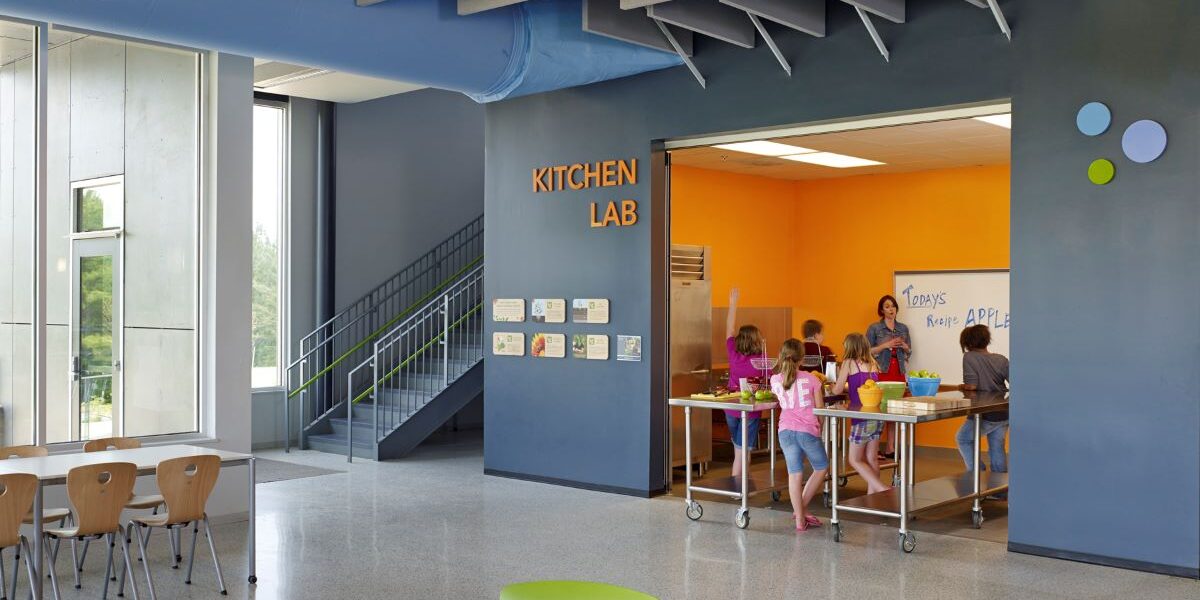“We have such a brief opportunity to pass on to our children our love for this Earth, and to tell our stories. These are the moments when the world is made whole.”
– Richard Louv, journalist and author
Our childhood memories of eating in school cafeterias and classrooms tend to leave a lasting influence on our lives. Whether it is the friends we made at lunch, what food was served, or the sense of freedom we experienced after lunch at recess, these memories shape our identities and influence our lives. We all carry with us these recollections, which serve as a testimony to the importance of mealtime at school in shaping our attitudes and outlook into adulthood.
Memories are not merely anecdotal; it is backed by research indicating that schools play a crucial role within our communities as centers for knowledge, health, and community well-being.
Charisse Nixon, a developmental psychologist, underscores this in her TED Talk, “Thinking Across Boundaries – What Adolescents Need to Thrive,” emphasizing that meaningful relationships are fundamental to fostering resilience in young people. In essence, meaningful connections, relationships, and a sense of purpose are essential for nurturing healthy individuals and communities.
It is with this understanding that our interdisciplinary team embarked on a mission to envision a new generation of healthy, active, welcoming schools with children at the center of this discussion about school dining spaces.
Our research addresses school food environments as a new type of learning environment, where children learn to eat together — as much as they learn what to eat and how healthy, nutritious food is integral to the cycles of life.
This initiative began 12 years ago, in response to the escalating epidemic of obesity, a serious health problem in the U.S. where 1 in 5 children and adolescents are affected (CDC.gov). While agencies conduct ongoing research to comprehend the root causes of childhood obesity, our focus has been on comprehensively understanding the role of schools and developing design guidelines for school architecture in promoting well-being of children within the everyday school routine.
Dining is central to this transformative vision for schools in prioritizing health for the next generation of active, engaged, food-smart kids.
Collaborative Efforts for Visionary Transformation
In 2012, our design research team pioneered this work alongside a team of visionary educational leaders who prioritized health and well-being for their PreK-5 school redesign. The project brought together architects, educators, public health scientists, a pediatrician, kinesiologists, and food service experts to explore holistic approaches to addressing healthy school food environments.
We tackled essential questions regarding the imperative of ensuring every child’s right to flourish within and beyond the school setting by reimagining where children learn to eat as the heart of the transformative change. With robust dialogue and empirical research, we leveraged strategies that prioritize holistic well-being with school dining as the centerpiece of every child’s day at school.
Since 2012, we have continued to advocate for, replicate, and inspire innovative designs for dining environments as a critical component aligned with the academic plan, wellness policies, and sustainable food operations.
A healthy school known for its dining and food environment is one that fosters children’s sense of belonging, choice, agency, and engagement as the most important communal social setting.
Teaching children to come together to the table, to share a meal together, to immerse themselves in the school garden, can transform lives and therefore, the communities they serve. What we have found is what unifies experts across these disciplines is the advocacy from students urging us to integrate their perspectives for more meaningful and lasting change.
Our Healthy Eating Design Guidelines for School Architecture endeavored to center children – as well as teachers, staff, and community members – in identifying the components of a supportive food environment ecosystem that enables every child to thrive.
In essence, meaningful engagement in the dining environment is crucial for children’s growth and development within the context of a vibrant social setting, one that ensures inclusivity as an integral aspect of human flourishing rather than a competing priority.
Our aim is to foster designs for dining and food environments that support the holistic well-being of the whole community. Presently, the landscape of U.S. education is undergoing a paradigm shift from a hyperfocus on academic performance to a broad view of learning as a pathway to human flourishing, with health as an integrated continuum throughout one’s life course.
This shift is imperative, as empirical evidence suggests that prioritizing academic achievement at the expense of students’ emotional and physical well-being is untenable. Therefore, our investments must stand behind children’s need for holistic growth and development at the school level.
As we continue to gather research insights from various perspectives, a recurring theme emerges – the importance of fostering a sense of belonging within school communities. This sense of belonging, characterized by being seen, heard, known, accepted, and connected to others, lies at the heart of creating safe and welcoming dining and food environments.
Belonging, drawn from the Samuel Centre for Social Connectedness, emphasizes connections to people, place, power, and purpose, underscoring the multifaceted nature of belonging as being able to make a positive difference in the world around us.
Dining Designed to Reconnect with Nature, Ourselves, and One Another
With our mission to promote innovation and impact, we developed 10 design domains for the Healthy Eating Design Guidelines for School Architecture to help schools make their spatial transitions from a rigid, adult-centered paradigm to an agile, learner-centered environment rooted in our shared values for health and well-being.
The design domain focused on furniture aims to proactively and strategically develop layouts that emphasize the importance of social connection and belonging within school as a community.
Furniture designed to enhance body-mind connections, and move us from inside to outside, has the power to transform the dining experience into a vital, social place for nurturing children and fostering community well-being.
A beautifully designed dining room (however big or small) is a place people want to go to linger, mingle, relax, and enjoy the camaraderie, laughter, storytelling that comes with mealtime.
Furniture in this type of learning context, a healthy dining environment, possesses the power to shape memorable experiences, forge lasting connections, and inspire meaningful interactions – recollections we carry with us into adulthood.
Thus, our research findings begin to shed light on how school architecture and the furniture that activates learning plays a pivotal role in creating healthy, inclusive environments that nurture the holistic development of every child.
Dina M. Sorensen is the founder and design director of d.studio. She is also co-chair of the American Institute of Architects – Committee on Architecture for Education Research Sub-committee. To request the Healthy Eating Design Guidelines or Sorensen’s latest project, Insights: Healthy by Design | Dining, done in partnership with VS America and several experts, email info@vsamerica.com.










